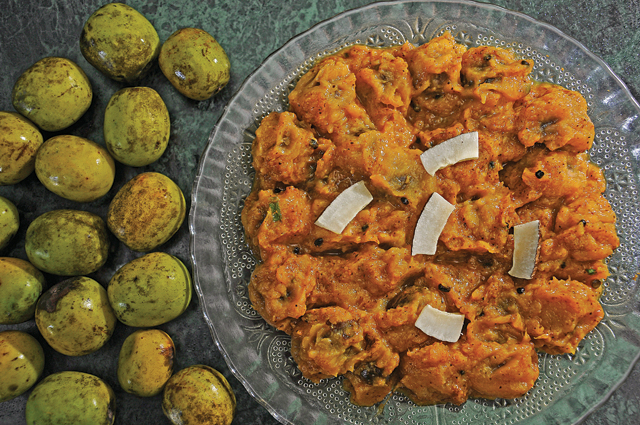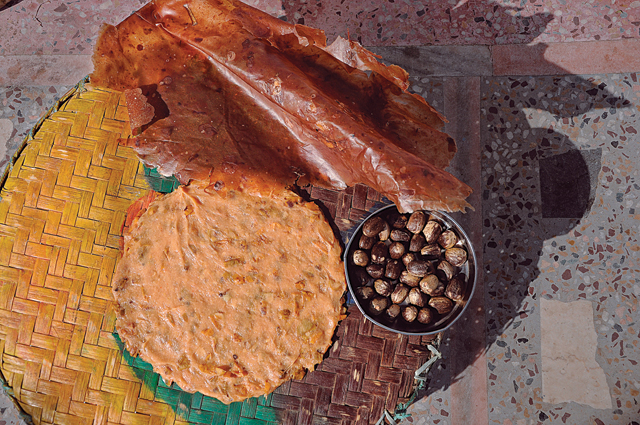The fruit is central to a plethora of different cuisines in Nepal, but what makes it special?

Last year they hacked down the lapsi tree in our yard. They say the lapsi must never be planted where you reside, for it pulls together all the negative energy from its surroundings. Where ever the sour fruit grows, calamity is always lurking. When the news arrived that Munu didi, a caretaker who has been with the family for decades, lost a cousin in her village after he fell from a lapsi tree during harvest, my parents decided the fruit was not worth the risk. The tree was gone before Munu didi returned from the funeral.
All the while, unable to persuade my parents otherwise, I was tormented by one question— how could a fruit that brings such delight to so many, be brandished with such malignant myths?
Everybody, after all, has a favorite lapsi memory.
My own sweet and tart romance with lapsi began in the early days of my life. I remember shopping for lapsi in Birgunj with my grandmother; she used to haggle with the vendors over the many kilos that she intended to buy. She would then spend the next few days meticulously boiling the yellow-green fruits before peeling them by hand.
I can still vividly picture her wrinkled fingers tirelessly stooping down to pick up one more fruit. She wouldn’t stop until she had jars upon jars of Lapsi pau (pickle) to travel home with. Once back in Kathmandu, the jars found their way to the relatives’ near and far, and would earn rave reviews. Every jar she produced was a valued commodity.
I understood the worth of her magical lapsi ko achar when I was in boarding school. Those who have lived through the culinary hell of boarding schools will attest that its dining is at best, dodgy. Dinner (or any meal really) consisted of the same dal-bhat-tarkari formula— no pickle, no extra seasoning, just plain rice and lentils. Often, I would feign a stomach ache just to skip the boring meal.

All that changed, however, whenever a little jar of lapsi ko achar, filled with mom’s love and grandma’s skills, handed down over generations, arrived. Meals suddenly rediscovered the tangy twist that had been missing. My body would twinge in delight. Goose bumps would shoot up my arms as I would wolf down the tart flesh of the pickled fruit. It tasted heavenly, it tasted of home.
Lapsi, or Choerosopndais axillaris to those in lab coats, is a popular fruit tree considered native to Nepal, has over time spread to other Asian countries. As winter sets in, the deciduous lapsi tree bears a greenish yellow fruit with a sour white flesh cocooning a large oval seed.
In Nepal there is a long-standing tradition of using lapsi in many dishes and preservatives. A ripe lapsi has a pleasant tart flavor, and some people like to eat it fresh. But it is more popularly used to make dried fruit nuggets, fruit leather or the legendary lapsi ko achar (a fruit pickle).
Lapsi fruits are allowed to remain on the tree until they are ripe. Once they get the yellowish-green color, the pulp becomes soft and falls easily off a branch with a rigorous shake. The skin is tough when fresh, but can be easily peeled off after it is boiled.
The skin (lapsi ko bokra) is also dried to be used as fruit leather (paun) or a souring agent for cooking.
Lapsi ko achar is among the most popular pickles in Nepal. This rich brown and gooey pickle is sweet, spicy and tangy at the same time. Though each family boasts of its own unique recipe, the lapsi fruit is boiled until tender before it is peeled -- keeping the pulp and the seed intact.
The peeled fruit is then cooked in oil, and with spices such as sugar, fenugreek seeds, dried chilies, turmeric, cinnamon, ground cardamom, fennel seeds and chopped dried fruit. Once the pickle is cooled, it is packed in jars. At room temperature, it stays good up to a year at room temperature.
The lapsi, or Nepali Hog Plum, boasts other qualities as well. Rich in Vitamin C, the fruit is used in many traditional medical practices. The hard oval seeds serve as fire starters in rural kitchens, or double as champutees— marbles for kids. The timber is also sturdy and is ideal for furniture or building.
In the recent years, lapsi has also found tremendous scope as commercial candies that line the retail and department stores across the country. And as traditional skill and patience required to make the delicacies from scratch wanes, it is also mass produced in Mason jars as ‘home-made pickles’.
Hajuri Bista (“everybody’s favorite grandma”) is one of the leading pickle chefs in the country. At her factory in Nakkhu, she produces an assortment of pickles under the brand name Navaras. The brand sells its products in most department stores in the country. Her prized recipe, she admits, is her lapsi ko achar.
“Lapsi is my personal favorite,” she says with a childlike giggle. “I, like so many others, have fond memories attached to it.” She remembers her school days when she used to splurge all of her allowance buying lapsi candies. “I would walk from school all the way to my home in Dillibazar, licking my fingers and smacking my lips. I am just happy that I could continue to pass on the same joy to my customers as well.”
Before lapsi products became ubiquitous in the market, they were a highly prized delicacy produced by tireless grandmas. They also played a central part in feasts hosted by Newars of the Valley. In fact, no lapte bhwey (a traditional Newari feast) is complete without a serving of a pau kwa, a thick lapsi soup.
Any Newari feast has four servings; the first two go together. The ‘food of the devil’ or meat and alcohol take the heaviest toll on the digestive system. The ‘food of the human’ (beaten rice, vegetables and greens) make for easier digestion, but still require effort. These two courses are served together (with the second and third helpings) at the beginning of the feast.
Once these two courses are finished, the feast breaks for an ‘ayurvedic’ course. The guests are served fenugreek, which helps to negate the effects of the oil and grease that has been consumed. The diners then are served with generous portions of the lapsi soup or pau kwa — considered to be a digestive aid. It is believed that it not only helps catalyze digestion, but also purifies the elements. It is only when pau kwa has been served that the feast can move on to the last serving, the ‘food of the gods,’ (fruits and Juju Dhau). This requires no effort to digest.
Newars of the Valley and beyond are known for their lavish and frequent feasts. Without lapsis, however, they wouldn’t be able to balance the food from the ‘three realms’.
Even though lapsi trees continue to be chopped down for bad luck and negative energy, there is no denying that lapsis have something positively magical about them.
Over the centuries, lapsi has carved a unique place in the Nepali imagination and the diet. The burgeoning Nepali Diaspora lists these hog plums as the ‘things they most miss about home’ (second only to momos, of course).
Lapsi, more importantly, has stood the test of time. It continues to be popular even today, with the young and the aging alike, just as it had been with members of the generations before them. Everybody, after all, has a favorite lapsi memory.











